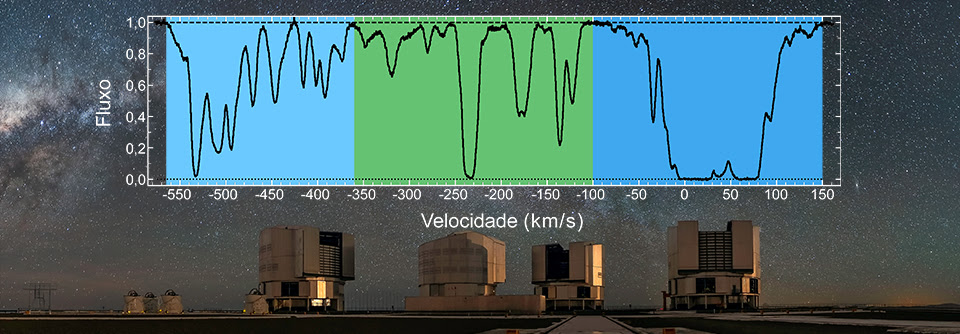The ESPRESSO high-resolution spectrograph, mounted on the Very Large Telescope from the European Southern Observatory, was recently used to measure the fine structure constant, one of the fundamental constants of the Universe. This work had the participation of several researchers from the Institute of Astrophysics and Space Sciences.
Could it be that the laws governing the Universe were the same everywhere and throughout the life of the Universe, or could they vary? Why is gravity so much weaker than electromagnetism?
To try to answer these questions, an international team, which includes the participation of several researchers from the Institute of Astrophysics and Space Sciences (iastro), used the ESPRESSO spectrograph, to measure with high resolution the fine structure constant, or alpha ().
Installed in Paranal Observatory of ESO, the ESPRESSO combines its unique stability with the incredible collecting power of the Very Large Telescope (VLT). The results were published in the journal Astonomy & Astrophysics.
Carlos Martins (IAstro & University of Porto), co-author of the article and researcher responsible for the project CosmoESPRESSO from IAstro, explains that "the fundamental constants of the Universe, such as , are vital for understanding the functioning of the Universe, but it is not known why they have the value they have, if they have always had the same value throughout the History of the Universe or if they vary from place to place”.
Michael Murphy (Center for Astrophysics and Supercomputing, Swinburne University of Technology & Institute for Fundamental Physics of the Universe), the first author of the article, comments: “This is a mystery, at the heart of everything we know about the functioning of Nature. We can only say that these quantities are constant, because in our measurements we never detected one that varied”.
Martins adds: “Some theories, which go beyond the standard model, suggest that the fine structure constant can vary with time or space, so over the past few decades hundreds of measurements have been taken, some of which seem to indicate that , over the billions of years of the Universe, this would have varied by about 10 parts per million. However, it was not known whether these variations were just a result of the limited resolution of the instruments used”.
Verifying whether these constants are, in fact, truly constants is a true test of the fundamentals of current physics, but it was necessary to take measurements with high-precision instruments such as the ESPRESSO.
The team used this spectrograph to measure , which depends on the electron charge (e), Planck's constant (h) and the speed of light (c), and so can be used as a measure of the electromagnetic force, one of the four forces. fundamentals of the Universe.
By observing light from a distant quasar that passed through an absorption nebula in our line of sight, the team found that, 8,4 billion years ago, the electromagnetic force in that nebula was the same as that measured on Earth today.
Paolo Molaro (INAF - Osservatorio Astronomico di Trieste & Institute for Fundamental Physics of the Universe), the coordinator of this project, explains that the ESPRESSO “is a 'super-stable' spectrograph, mounted in a vacuum chamber, in an isolated laboratory, under the four telescopes of the VLT. The spectrum of our quasar has also been calibrated with the ESPRESSO's 'color ruler' – a frequency laser comb that allows us to know, with much more precision than hitherto, the wavelength of light at any point in the spectrum.” This allowed the team to measure the fine structure constant with an accuracy of 1,3 parts per million, the most accurate measurement ever made.
Martins adds: “As physicists, we always want to discover something that is not explainable by current knowledge, because we have to learn something new. In this case, we want to find out whether alpha varies or not. If it varies, it will shape the physics of the next few decades. But these stricter upper limits also help to better understand one of the greatest mysteries of modern cosmology: What is Dark Energy, one of the goals of the CosmoESPRESSO team”.
These results, which now serve as the basis for measurements with next-generation instruments such as the HIRES spectrograph, which will be mounted on the Extremely Large Telescope (ELT) from ESO, demonstrate that the accuracy of the results is only limited by the amount of light that can be collected – something that will increase considerably with the ELT's 39,3 meter modular mirror.




















Comments